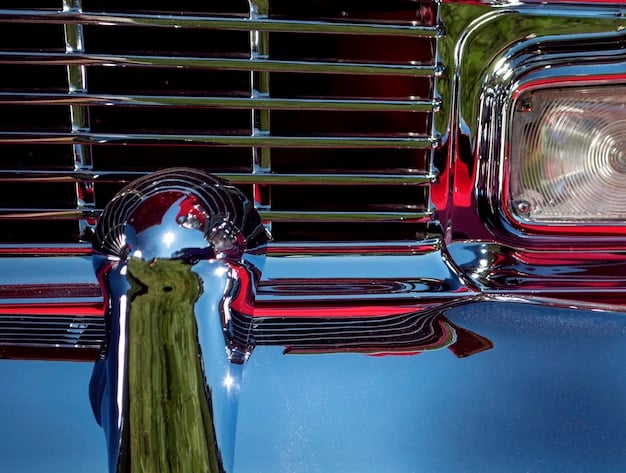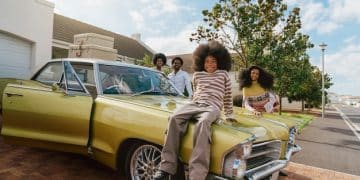The Evolution of Car Shows: A History of Automotive Spectacles

The evolution of car shows unveils a transformation from modest local gatherings to grand national spectacles, reflecting the changing landscape of automotive culture and technological advancements.
The story of the evolution of car shows: From Local Gatherings to National Spectacles is one of passion, innovation, and community. What began as simple get-togethers for enthusiasts has morphed into elaborate showcases, shaping automotive trends and culture along the way.
Tracing the Roots: Early Car Shows
Car shows, in their earliest form, were far from the extravagant events we see today. They originated as modest meetings, primarily focused on displaying the recent advancements in automotive technology and design. These initial gatherings laid the groundwork for what would become a global phenomenon.
The Dawn of Automotive Display
Early car shows were more about function than aesthetics. Manufacturers used these events to showcase new models and innovations, attracting potential buyers.
Key Innovations on Display
From advancements in engine technology to new body designs, early car shows were a hub for automotive innovation.
- Engine Technology: Early shows often highlighted advancements in engine power and efficiency.
- Body Design: Manufacturers showcased new body styles and materials.
- Comfort Features: The addition of features like enclosed cabins and improved seating were major attractions.
These early shows were vital for the development and acceptance of cars as they helped introduce the public to this new form of transportation, gradually turning skeptical observers into eager adopters. They showcased not only the vehicles themselves but also the promise of what cars could be in the future.

The Rise of National Car Shows
The transition from local gatherings to national spectacles marked a pivotal moment in the history of car shows. As automotive technology advanced, so did the scale and ambition of these events. This era saw the emergence of iconic shows that continue to influence car culture today.
This shift to national car shows reflected the growth of the automotive industry and the increasing popularity of cars among the general population.
National car shows began to draw larger crowds and feature more international brands, becoming significant cultural events.
These large-scale events not only showcased the latest models but also set trends and shaped consumer tastes. Manufacturers invested heavily in creating eye-catching displays and interactive exhibits to capture public attention.
The rise of national car shows also led to increased media coverage, further amplifying their impact on the automotive market.
These developments marked the beginning of car shows as a vital marketing platform for automakers worldwide.
The Influence of Car Culture and Customization
As car shows evolved, they began to reflect the growing influence of car culture and customization. Enthusiasts started modifying their vehicles, transforming them into unique expressions of personal style. Car shows became a platform for showcasing these creations and celebrating automotive individuality.
The Custom Car Revolution
The custom car movement brought new energy and creativity to car shows. Enthusiasts displayed their customized vehicles, inspiring others to personalize their rides.
Emergence of Car Clubs
Car clubs played a vital role in promoting car culture. They organized shows and gatherings, fostering a sense of community among enthusiasts.
The transformation of car shows from manufacturer-driven events to showcases of personal expression significantly broadened their appeal. The customization trend encouraged community involvement, fostering a sense of belonging among car enthusiasts.

This period marked a shift towards inclusivity and cultural expression within the automotive world; Car shows were not just places to see new models but evolved into cultural centers where unique creations reflected individual identities and passions, enriching the car culture.
The Age of Automotive Innovations
Technological innovation has always been a driving force behind the evolution of car shows. As cars became more advanced, car shows became a prime venue for showcasing cutting-edge technologies.
Electric and Hybrid Vehicles
The introduction of electric and hybrid vehicles brought new excitement to car shows. Manufacturers highlighted the benefits of these eco-friendly options, gaining public interest and support.
Advanced Driver-Assistance Systems (ADAS)
ADAS technologies have also become a major attraction at car shows. Demonstrations of features like adaptive cruise control and lane-keeping assist have helped educate consumers about safety innovations.
- Connectivity: The integration of smartphones and cloud services has transformed the driving experience.
- Autonomous Driving: The development of self-driving technology has generated significant buzz at car shows, indicating the future of transportation.
The impact of technology on car shows has been transformative. It changed the way visitors interact with vehicles and reshaped their expectations of what a car can do.
Global Car Shows: A Worldwide Phenomenon
The expansion of car shows beyond national borders has transformed them into a global phenomenon. International car shows bring together manufacturers, enthusiasts, and media representatives from around the world, fostering cross-cultural exchange and collaboration.
Major International Car Shows
Events like the Geneva Motor Show, Frankfurt Motor Show, and Tokyo Motor Show serve as global platforms for unveiling new models and technologies.
Regional Variations
Car shows in different regions cater to local tastes and preferences, reflecting the diversity of automotive cultures worldwide.
The proliferation of global car shows demonstrates their universal appeal and economic significance, thus promoting competition and innovation among automakers, leading to better products and more exciting experiences for car enthusiasts worldwide.
The Future of Car Shows: Trends and Predictions
Looking ahead, the future of car shows will be shaped by several key trends, including virtual reality, personalized experiences, and sustainable technologies. These developments promise to make car shows more interactive, engaging, and environmentally friendly.
Virtual and Augmented Reality
VR and AR technologies offer new ways for visitors to experience cars. Virtual test drives and interactive displays provide immersive experiences.
Personalized Experiences
Car shows can now offer personalized experiences based on visitor preferences. Customized tours and demonstrations cater to individual interests.
Sustainability Focus
There is a growing emphasis on sustainability at car shows. Displays of electric vehicles, renewable energy solutions, and eco-friendly innovations reflect this trend. Here are some examples:
- Alternative Fuels: Showcasing vehicles powered by hydrogen, biofuels, and other sustainable energy sources.
- Green Manufacturing: Highlighting the sustainability of vehicle production processes.
The evolution of car shows continues, adapting to new technologies and changing consumer expectations. The future promises even more exciting and interactive experiences, making car shows an essential part of automotive culture. As car shows evolve with technology and sustainability, they will remain vital platforms for shaping the future of the automotive industry.
| Key Topic | Brief Description |
|---|---|
| 🚗 Early Car Shows | Focused on displaying new models and automotive tech advancements. |
| 🌟 Rise of National Shows | Transition to large-scale events setting trends and shaping tastes. |
| 🎨 Car Culture Influence | Customization era celebrated individuality in automotive design. |
| 🌱 Future Trends | Virtual reality, personalized experiences and sustainability. |
FAQ
▼
Early car shows were mainly aimed at showcasing new automotive models and technological innovations to the public, helping to increase adoption and improve public perception of automobiles.
▼
National car shows impacted the automotive industry by setting trends, driving consumer tastes, and serving as key marketing platforms for international brands, significantly influencing sales.
▼
Car culture has significantly increased the appeal and audience by including custom vehicle displays, thus encouraging community and car personalization during shows.
▼
Electric cars and other sustainable technology are becoming highly prominent in today’s auto shows, drawing attention to their environmental and functional benefits as more consumers become eco-conscious.
▼
The ongoing incorporation of advancements like augmented reality (AR), virtual reality (VR), plus a growing focus on sustainability, all work towards richer experiences that enable customisation choices and more eco-friendly alternatives. Car programmes will become interactive.





